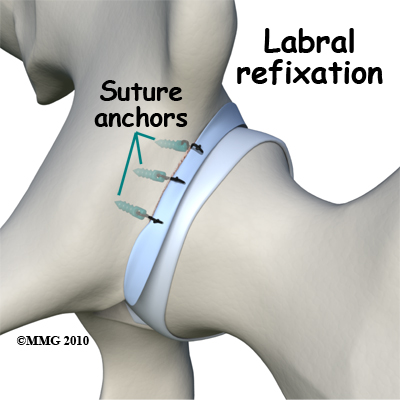What should I expect after surgery?
Rehabilitation at STAR Physical Therapy following surgery for FAI should begin as soon as your surgeon allows it. Each surgeon will set his own specific restrictions based on what was done during the surgical procedure, their personal experience, and whether your tissues are healing as expected. Generally speaking, the more complex the surgery the more involved and prolonged your rehabilitation program will be. In any case, activity restriction is important for the first few weeks after surgery in order to avoid fatiguing or overloading the hip muscles.
If you are still using crutches by the time we first see you at STAR Physical Therapy, your physical therapist will ensure you are using the crutches safely, properly, and confidently and that you are abiding by your weight bearing restrictions. We will also ensure that you can safely use your crutches on stairs. If you are no longer using crutches, or once you no longer need them, your physical therapist will focus on normal gait re-education so you are putting only the necessary forces through the surgical side with each step, and are not compensating in any way. Until you are able to walk without a significant limp, we recommend that you continue to use your crutches, or at least one crutch or a cane/walking stick. Improper gait can lead to a host of other pains in the knee, hip and back so it is prudent to use a walking aid until near normal walking can be achieved. Your physical therapist at STAR Physical Therapy will advise you, along with recommendations from your surgeon, regarding the appropriate time for you to be walking without any walking aid at all.
During your first few appointments at STAR Physical Therapy your physical therapist will focus on relieving any pain and inflammation you may still have from the surgical procedure itself. We may use modalities such as ice, heat, ultrasound, or electrical current to assist with decreasing any pain or swelling you have around the surgical site or anywhere down the limb. In addition, your physical therapist may massage your hip, leg or ankle to improve circulation and help decrease your pain.
The next part of our treatment will focus on regaining normal range of motion in your hip. Your physical therapist at STAR Physical Therapy will prescribe a series of stretching and strengthening exercises that you will practice in the clinic and also learn to do as part of a home exercise program. Range of motion in the hip generally comes back very quickly after surgery, but it still depends on what your surgeon has done inside your joint as well as the state of your joint prior to surgery. Rehabilitation will focus not only on regaining range of motion that may have been restricted due to the surgical process, but will particularly focus on improving flexibility and correcting imbalances that may have contributed to the impingement in the first place now that the anatomical issues have been corrected by the surgical procedure. Stretches for the front and back of your hip, particularly the hip flexors and the hip external rotators and abductors (deep gluteals) will be prescribed. An exercise bike at this stage is very useful to assist in gaining back the hip flexion and extension range of motion as long as the bike seat is kept high enough to avoid pinching of the hip during the flexion portion of the pedal cycle. Even if you are unable to fully rotate the pedals of the bike this activity it is still encouraged; performing the back and forth motion forces fluid through the joint and greatly assists the healing process.
If necessary your physical therapist will mobilize your hip joint. This hands-on technique encourages the hip to move gradually into its normal range of motion. Mobilization of the hip may be combined with assisted stretching of any tight muscles around the surgical site. Particular attention will be taken such that the healing structures of the hip are not impinged at all during mobilizations of the area.
At STAR Physical Therapy we also highly recommend maintaining the rest of your body’s fitness with regular exercise while your hip is healing. This can begin very early post-surgically. You can use an upper body bike if you are non-weight bearing or may even be allowed to do aerobic exercises in a pool as long as it doesn’t compromise the hip. A stationary bike is often the best cardiovascular activity once the surgical structures have healed enough and you can put some weight through your foot. Weights for the upper extremities and other leg are also strongly encouraged. Your physical therapist at STAR Physical Therapy can provide a program for you to maintain your general fitness while you recover from your surgery.
As soon as possible your therapist will prescribe strengthening exercises specifically for your surgical hip. These exercises will focus on restoring any muscle imbalances that have either been contributing to the impingement or that have developed due to the impingement. The deep gluteal muscles, in particular, will require specific attention as they are the major supporters of your hip joint, and also play a major role in controlling the position of your lower limb in standing. Exercises for your core area are also important and will be prescribed. Strengthening exercises that work the muscles while in standing most effectively assist with daily activities such as walking and stair climbing, however other very effective exercises for your gluteals in a lying position can be prescribed for the period while you are partial weight bearing. Your therapist may use an electrical muscle stimulator to assist your muscles in contracting as you do your exercises; this will help you to more rapidly gain your strength back. Exercises may also include the use of exercise bands or weights to provide added resistance for your hip and lower extremity. If you have access to a pool, your physical therapist may suggest you go into the pool to do your exercises. The buoyancy of the water along with the warmth and hydrostatic properties can assist greatly in providing comfort to the hip joint and often allows your exercises to be done more easily with less discomfort. As soon as you are able, however, it is important to start land-based exercises as these more closely simulate your normal everyday activities.
As a result of any injury, the receptors in your joints and ligaments that assist with balance and proprioception (the ability to know where your body is without looking at it) decline in function. A period of immobility and reduced weight bearing will add to this decline. If your balance and proprioception has declined, your hip joint and your limb as a whole will not be as efficient in its functioning and this may contribute to injury in the future. As a final component of our treatment your physical therapist at STAR Physical Therapy will prescribe exercises for you to regain balance and proprioception. These exercises might include activities such as standing on one foot or balancing on an unstable surface such as a wobbly board or a soft plastic disc. Advanced exercises will include agility type drills such as light hopping or moving side to side.
As your range of motion, strength, and proprioception improve, your physical therapist will advance your exercises to ensure your rehabilitation is progressing as quickly as your body allows. As soon as it is safe to do so, your therapist will add more aggressive exercises such as jumping, hopping, and running, or exercises that mimic the sports or recreational activities that you enjoy participating in. During all of your exercises you physical therapist will pay particular attention to your technique to ensure that you are not using any compensatory patterns or are developing bad habits in regard to how you use your hip and lower extremity. Enduring pain in your hip for years, months, or sometimes even just weeks usually causes you to use your hip and lower extremity in a pattern that avoids or limits your pain, but that is not efficient for a normal hip. If you do not pay close attention to how you use your joint and limb post-surgically these patterns often continue to occur once the source of your pain has been eliminated by surgery. Further hip impingement can occur. Your physical therapist at STAR Physical Therapy will be crucial to providing you with feedback regarding correcting these patterns and developing new, efficient patterns during your daily activities.
Approximately five to six months after surgery your physical therapist will guide you back to full activities including your sporting activities. Many patients report continued improvements in their symptoms even up to the end of the first year after surgery.
Generally the rehabilitation after surgery for FAI responds very well to the physical therapy we provide at STAR Physical Therapy. If for some reason, however, your pain continues longer than it should or therapy is not progressing as your physical therapist would expect, we will ask you to follow-up with your surgeon to confirm that the hip is tolerating the rehabilitation well and to ensure that there are no complications that may be impeding your recovery.
Portions of this document copyright MMG, LLC
STAR Physical Therapy provides services for physical therapy in Fairport and Rochester.
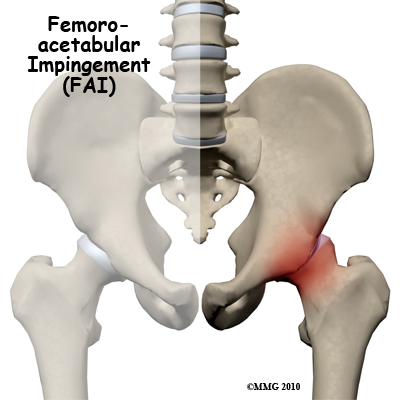 Femoroacetabular impingement (FAI) occurs in the hip joint. Impingement refers to some portion of the soft tissue around the hip socket getting pinched or compressed. Femoroacetabular tells us the impingement is occurring where the femur (thigh bone) meets the acetabulum (hip socket). There are two different types of impingement. They differ slightly depending on what gets pinched and where the impingement occurs.
Femoroacetabular impingement (FAI) occurs in the hip joint. Impingement refers to some portion of the soft tissue around the hip socket getting pinched or compressed. Femoroacetabular tells us the impingement is occurring where the femur (thigh bone) meets the acetabulum (hip socket). There are two different types of impingement. They differ slightly depending on what gets pinched and where the impingement occurs.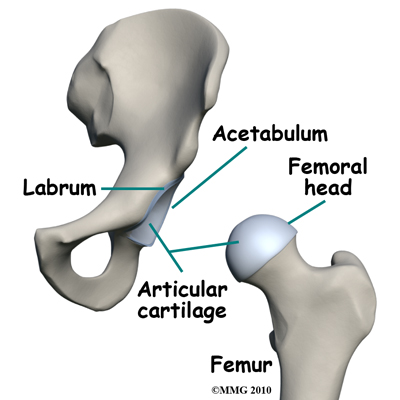 Femoroacetabular refers to the place in the hip where the round head of the femur (thigh bone) comes in contact with the acetabulum or hip socket. Two types of impingement are known to cause pinching of the soft tissues in this area: The first is called cam-type impingement. This occurs when the round head of the femur isn't as round as it should be. It's more of a pistol grip shape.
Femoroacetabular refers to the place in the hip where the round head of the femur (thigh bone) comes in contact with the acetabulum or hip socket. Two types of impingement are known to cause pinching of the soft tissues in this area: The first is called cam-type impingement. This occurs when the round head of the femur isn't as round as it should be. It's more of a pistol grip shape.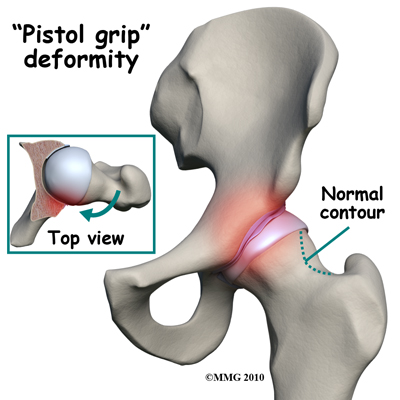
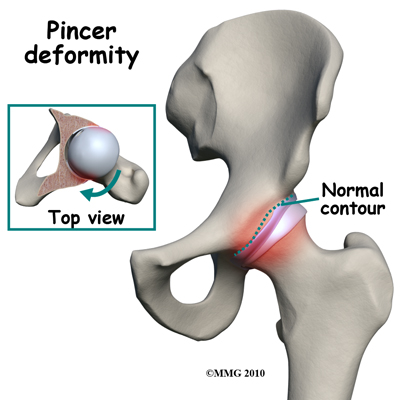
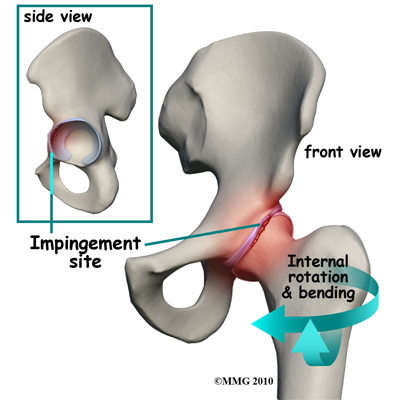 Normally, the femoral head moves smoothly inside the hip socket. The socket is just the right size to hold the head in place. If the acetabulum is too shallow or too small, the hip can dislocate. In the case of FAI, the socket may be too deep.
The rim of the cartilage hangs too far over the head. When the femur flexes (bends) and internally rotates, the cartilage gets pinched. Over time, this pinching or impingement of the labrum can cause fraying and tearing of the edges and/or osteoarthritic changes at the impingement site.
At the same time, with changes in the shape and structure of the hip, there are changes in normal hip movement. There may be too much hip adduction and internal rotation. Hip adduction refers to movement of the leg toward the body. Muscle weakness of the hip abductor muscles, hip extensors, and hip external rotators add to the problem. Hip abduction is moving the leg away from the body.
With the combined effects of anatomic changes in the hip and the resultant muscle imbalances, repetitive motions can create mini-traumas to the hip joint. The result can be an additional problem: partial or complete labral tears. A complete rupture is referred to as an avulsion which indicates that the labrum is separated from the acetabular cartilage where it normally attaches.
Normally, the femoral head moves smoothly inside the hip socket. The socket is just the right size to hold the head in place. If the acetabulum is too shallow or too small, the hip can dislocate. In the case of FAI, the socket may be too deep.
The rim of the cartilage hangs too far over the head. When the femur flexes (bends) and internally rotates, the cartilage gets pinched. Over time, this pinching or impingement of the labrum can cause fraying and tearing of the edges and/or osteoarthritic changes at the impingement site.
At the same time, with changes in the shape and structure of the hip, there are changes in normal hip movement. There may be too much hip adduction and internal rotation. Hip adduction refers to movement of the leg toward the body. Muscle weakness of the hip abductor muscles, hip extensors, and hip external rotators add to the problem. Hip abduction is moving the leg away from the body.
With the combined effects of anatomic changes in the hip and the resultant muscle imbalances, repetitive motions can create mini-traumas to the hip joint. The result can be an additional problem: partial or complete labral tears. A complete rupture is referred to as an avulsion which indicates that the labrum is separated from the acetabular cartilage where it normally attaches.
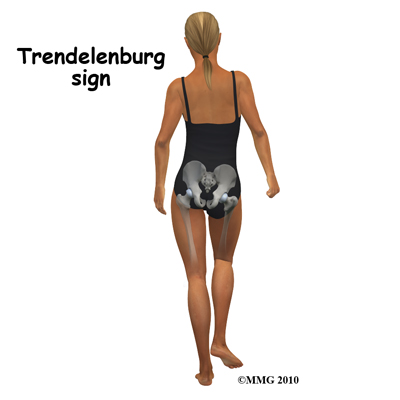
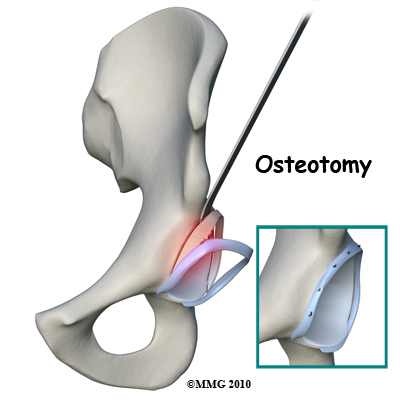 With the fully open surgical procedure, the head of the femur is dislocated from the socket to make the changes and corrections and reshape it. With arthroscopic surgery, hip dislocation is not required. Osteotomy is done for pincer-type impingement.
Whenever possible, the surgeon tries to save the hip. When there is extensive damage to the cartilage, hip resurfacing or total joint replacement may be needed. There are many factors to consider when making the decision whether or not to do a hip replacement. These factors include the patient's age, findings on imaging studies, type and severity of deformity, as well as the presence of arthritic changes.
With the fully open surgical procedure, the head of the femur is dislocated from the socket to make the changes and corrections and reshape it. With arthroscopic surgery, hip dislocation is not required. Osteotomy is done for pincer-type impingement.
Whenever possible, the surgeon tries to save the hip. When there is extensive damage to the cartilage, hip resurfacing or total joint replacement may be needed. There are many factors to consider when making the decision whether or not to do a hip replacement. These factors include the patient's age, findings on imaging studies, type and severity of deformity, as well as the presence of arthritic changes.
